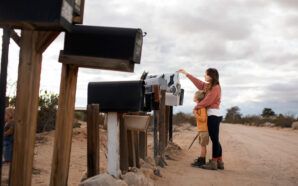Jeanne Kuang
CalMatters
It took years for CalVans to get its vehicles on the road legally.
The Central Valley transit agency, conceived after a 1999 crash that killed 13 farmworkers, leases strictly monitored vehicles to workers and employers to form vanpools.
It gives thousands of laborers a safe way to get to California’s vineyards, orchards and berry fields, and stands out as one solution to what regulators call a persistent problem: The agriculture industry transporting workers without authorization or safety checks.
The two-decade-old program is so popular that it operates nearly a thousand farmworker vanpools across California each season and labor contractors compete to reserve vehicles.
But CalVans now faces another regulatory hurdle — this time, state climate law.
As part of its ambitious goals to slash emissions and achieve carbon neutrality by 2045, California is pushing an array of first-in-the-nation policies to go electric. Among them is a rule from the California Air Resources Board that will require all local government agencies to gradually replace their fleets with zero-emission vehicles. Operators would either have to purchase only electric vehicles starting in 2027 or ensure their vehicles are zero-emission over time — 10% of vehicles by January 2025, 25% by 2028, half by 2031, 75% by 2033 and 100% by 2035.
CalVans officials say they believe they must comply, but their current program is so tailored to farm work that it won’t be easy. It plans to pilot electric vehicles this year in what will ultimately be a test of how to implement California’s clean air policies in the state’s rural and disadvantaged communities.
The Air Resources Board said those communities will benefit most from the policy. The heavily agricultural San Joaquin Valley has some of the worst air quality in the nation, harming residents who are disproportionately Latino and low-income.
“It is essential that they don’t get left behind in a move toward zero-emissions vehicle technology and clean air,” board spokesperson Kate Lamb wrote in an email.
Lamb declined to say how specific agencies should comply with the rule, and suggested CalVans might not need to do so, depending on how the agency is classified. She also noted the rule provides exemptions if EVs aren’t readily available. Facing a future in which all vehicles are transitioned to electric, CalVans officials say they’re willing to try.
To environmental advocates at the Oakland-based Greenlining Institute, the test shows the challenges of making the state’s climate policies work across diverse communities that don’t always use passenger cars or have access to public transit.
Román Partida-Lopez, the institute’s senior legal counsel for transportation equity, said much of climate policy is focused on personal electric vehicles, which “are only part of the solution.”
“We need to look at alternative modes and alternative ways to get electric vehicle deployment in those communities,” he said.
First among the challenges for CalVans: No automaker yet manufactures electric versions of its eight- to 15-person vans.
Large enough to carry a group of workers, but small enough not to require a commercial driver’s license, CalVans vehicles were selected specifically to provide farmworkers safe commutes while avoiding being classified as farm labor contractors who would be subject to costly regulations. To that end it was crucial, according to a CalVans document detailing the program’s history, that the van drivers be fellow farmworkers, rather than professional, commercially licensed drivers.
The goal was to provide an alternative to riding in unregulated vans run by contractors or foremen. A recent CalMatters investigation found that after California cracked down on vehicle safety in the early 2000s, fatal crashes involving commuting farmworkers have become more common in vans that the state doesn’t regulate.
To prepare for the electric vehicle rule, the agency last year agreed with Model 1, a dealer, to buy about 400 Ford electric cargo vans. They were built to haul goods or deliver packages, so another manufacturer will install seating and GPS devices to monitor safe driving.
The purchase is enough to fulfill the 2025 EV mandate, and CalVans officials have received the first dozen vans. But whether they will work long-term still depends on other factors.
CalVans director Georgina Landecho said the agency plans to select farmworker groups to test the new vans later this year, after it gets adapters to use the Tesla supercharger network.
Where will electric vans charge up?
Still, the overall lack of chargers in rural areas will remain a challenge.
And charging at those stations could still take as long as two hours, according to Model 1 vice president T.J. Matijevich, adding to the workday for a driver.
“I don’t want to put these out there and then have it be thought of as a failure right from the get-go,” Landecho said. “That was a number one angst that the agricultural community leaders had. You’re already having people volunteer to drive these vehicles, you don’t pay them and now you’re gonna have them sitting around waiting with a vehicle to charge?”
Unlike traditional public transit, the vans don’t get driven at the end of the day to a depot where they could be recharged overnight. Instead, the farmworkers drive them home, where they’re much less likely to have an EV charger. Matijevich said he’s working with CalVans to set up alternatives, including free chargers for workers who are able to install them at home, and potentially a centralized charging depot.
“The most difficult part about the transition is the infrastructure has got to be there,” Matijevich said. “Today, it’s not.”
At maximum charge and under the best driving conditions, the electric vans can run about 125 miles, Matijevich said.
Farmworkers could easily surpass that in two days’ commutes.
Jose Palma, a longtime farmworker from Visalia, gets up by 5 every morning. By 5:15, he’s driving to pick up 14 coworkers in a CalVans van.
On one morning in April, their commute was 30 miles one-way, to an orange grove near Porterville. But other weeks, he could be going as far as Delano, 50 miles away. They get off work around 3 p.m., but Palma must drop off his coworkers before going home.
The vanpool program is a safer way to get to work, Palma said, because he doesn’t have to worry about affording insurance or maintenance. The program charges fares based on mileage; he estimated each worker pays about $40 a week.
The van “has everything that the law requires,” he said as he trimmed orange trees near Porterville. “If I have any problems, they come and take care of it.”
For years, CalVans officials have known about the transition to cleaner vehicles.
In 2017, the Air Resources Board awarded the program $6 million to run a three-year hybrid vehicle conversion test. In 2019, 154 hybrid vans hit the road, cutting tailpipe emissions by 25%.
But the test didn’t work for the long commutes through rural roads and fields, and funding was redirected to other clean air projects.
“CalVans determined that the hybrid conversion technology was not well suited for the ongoing performance demands and wear-and-tear associated with continuous off-road use,” according to a board memo. “At present, no commercialized clean technology vehicles are capable of meeting the ongoing off-road performance demands, extended range requirements, and passenger capacity necessary for most agricultural vanpool applications.”
$90,000 for each electric van
Last year, CalVans turned to EVs out of necessity.
Manufacturing hold-ups during the pandemic made it nearly impossible for CalVans to buy regular gas vehicles to replace older vans, said agency director Landecho. So when Model 1 offered new retrofitted electric cargo vans, she took a chance.
“I didn’t have much of a choice. We could kill two birds with one stone,” she said.
The electric vans cost more than $90,000, more than double the gas versions.
Only 12 vans have been delivered amid funding delays. They’re being paid for mostly through agreements between CalVans and several affordable housing projects that are under construction. The partnerships allow developers to get more state funding for shuttles and vanpools, both for future residents and local workers.
The housing funds are so far the only state dollars that have gone toward new vehicles — electric or not, Landecho said. CalVans is otherwise funded mostly by the van leases themselves, and some subsidies from counties where the vans operate; it’s dipping into its own funds to cover rising van prices when the grants have come up short.
This year, the agency is hoping to land as much as $53 million in grants to add nearly 600 electric vans across 16 housing projects.
Lamb of the Air Resources Board pointed to another state program that subsidizes the purchase of electric vehicles for public and private fleet operators and to state grants for rural communities to install chargers.
Future funding for such subsidies is in question, as Gov. Gavin Newsom proposes cuts to electric vehicle programs to try to close a $56 billion deficit over the next two fiscal years.
Partida-Lopez at the Greenlining Institute said the state should help CalVans pay for electric vans, and the agency is also lobbying lawmakers to include funding in a proposed climate bond measure. But nothing concrete has materialized. The authors of the bond bills, Sen. Ben Allen and Assemblymember Eduardo Garcia, did not respond to requests for comment.
Landecho said she doesn’t want to pass on the costs of new vehicles to farmworkers who use the service.
“The person behind the wheel is not paid (to drive). There’s nothing special about folks who get behind the wheel of our vehicles,” Landecho said. “It’s folks who are just trying to get home from work.”





